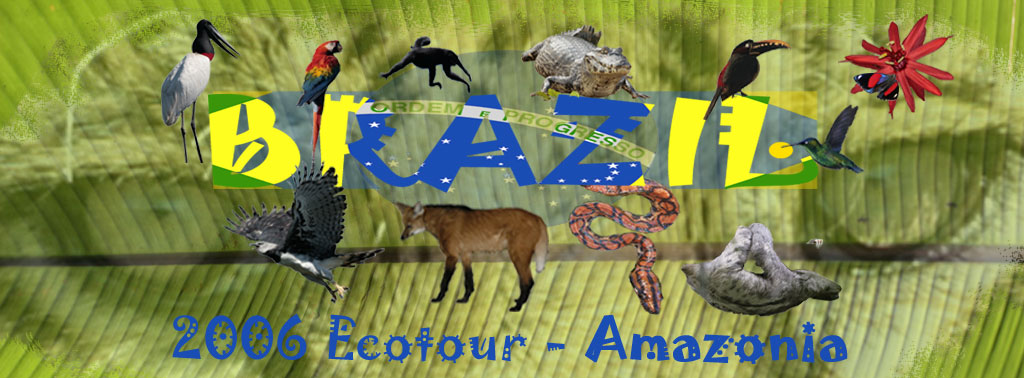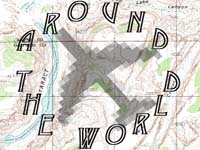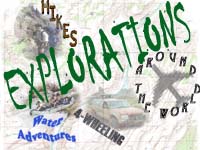
Amazonia Intro

Amazonia Intro
Added 3 September 2006
Of the three regions we visited, the Amazon is by far the best known, and also the most recognized as threatened, even though the Atlantic Rainforest is far more threatened, and the Pantanal is equally important and possibly more protectable. But where the Pantanal is huge, the Amazon is practically synonymous with massive. And of course the Amazon is, well, THE AMAZON, in a word: fabled. A trip to Brazil wouldn't have seemed like a trip to Brazil without going to the Amazon.
Our trip ended up being to the southern Amazon Basin, and we didn't get to see the Amazon River itself. We all would have loved to have seen the Amazon River, but it just didn't work out logistically or financially (primarily financially). Besides, I have been lead to believe that in order to see the Amazon of fable, the Amazon River may not be the best place to go. With an increasing population along the Amazon, it has become a major shipping lane and water highway supporting millions of people.
Interestingly, while the massive Amazon currently drains east into the Atlantic Ocean, it used to drain west into the Pacific Ocean. As the Andes were created by a collision of the South American plate with the Nazca plate 15 million years ago, the river was cut off from the Pacific and started flowing the other way. I can only imagine how big the lake must have been as the water backed up against the proto-Andes and had to reverse direction!
The Amazon basin is the largest rainforest in the world, covering an area roughly the size of the lower 48 contiguous states of the United States. It is also the largest river system in the world, with over 1,100 tributaries. Seventeen of those tributaries are more than 1000, miles long. Nearly 1/5th of the worlds freshwater supply dumped into the ocean comes from the Amazon. The Amazon is larger than the next five largest rivers in the world combined. The Amazon dumps an average of 28 BILLION gallons of water per minute into the Atlantic Ocean. Let's try to get a sense of that . . . That would be equivalent to 1.52 cubic miles of water per hour, 36.6 cubic miles per day, and 13,365 cubic miles per year. The Great Lakes in the Northern US and Southern Canada, which hold 20 percent of the world's freshwater, contain a combined volume of 5475 cubic miles, more or less. The Amazon could completely fill the all of the Great Lakes more than twice every year. (The Mediteranean and Black Seas combined contain about 1 million cubic miles of water though, so it would take the Amazon about 74 years to fill them up.) Still, this is enough water that freshwater from the Amazon can still be found well over 100 miles off shore into the Atlantic Ocean.
Yet once again, we find immensity shrinking rapidly by the new forces at work there. A 1997 study estimated that the Amazon was being deforested at a rate of 1-3 million hectares (3,860-11,580 square miles) per year. Deforestation peaked in 1995, dropped in the late 90s, and has been more or less steadily rising again since then, peaking again in 2004 before dropping off a bit in 2005 (based on official National Institute of Space Research (INPE) figures, presumably from satelite imagery). Around 60-70% of the deforestation in the Amazon is the result of cattle ranching. Most of the rest is the result of small scale agriculture, mainly by poor subsistence farmers just trying to survive. Industrial agriculture makes up 1-2% of the total, logging another 2-4%, and other factors such as fires, mining, roads and other development take another 2-4% of the forest. These are the pressures the Amazon is up against . . . well, plus a few more.
The Amazon is experiencing the worst drought on record right now. River levels have dropped by 50 feet or more in some areas. Some rivers have completely dried up, cutting off whole communities from their connection with the outside world and from supplies. The Brazilian army is currently engaged in the largest relief effort in its history to help the people of the Amazon. There are, of course, many factors in play for such a major drought to occur. One major factor is likely the warming of the Atlantic Ocean, likely a result of global warming (human caused or not, the earth IS warming), which effects currents and shifts moisture away from the Amazon. And of course it seems altogether reasonable that the immense loss of forest within the basin is having an effect as well. A rainforest creates a great deal of atmospheric moisture through a process called transpiration, or evaporation from leaves. Large scale habitat destruction can effect atmospheric moisture, and thus rainfall.
The story isn't all grim, though. The Brazilian government has recently created several new parks that offer some measure of protection, and groups of soy bean growers and processors have recently declared a two year moratorium (starting in October 2006) on trading soybeans grown on newly deforested land. They will use the moratorium period to try to find ways to better balance their agricultural processes with the needs of the ecosystem. Also, as the industry of eco-tourism continues to expand, the natural state of the Amazon will come to have a higher value that may, at least in some cases, outweight the value of the destruction of the forest for other uses.
Enter four intrepid travelers. For the Amazon is host to approximately 1/3 of the world's species. A single acre may contain over 100 species of trees, compared to perhaps 5 species per acre in the most diverse temperate forests of the United States and elsewhere. One any one of those 100 species within that acre, one might find about 45 species of ant. There are more species of fish in the amazon than in the entire Atlantic Ocean. The Amazon contains several million species of insect, tens of thousands of plants, and several thousand birds and mammals. And they're still counting! On top of that, 20% of the world's oxygen comes from the Amazon. Take a deep breath! This is why we went to the Amazon . . . to see each and every one of the several million species of insect! Ha ha, just kidding. We went to experience one of the oldest, most diverse ecosystems in the world.
We also went, admittedly, in part to simply see the Amazon while there is still some Amazon to see. And in truth, there is still a lot to see. A week could never do such a place justice, so we focused on one very small piece of it. And we tried to do so in a way to perhaps provide more good to the region than harm, and perform some small service to the Amazon.
With that in mind, we traveled to Alta Floresta, in the southern Amazon Basin. We spent most of our time there in a small jungle lodge with no electricity, solar "heated" showers, and natural, biological wastewater treatment areas for each bungalow. The lodge is carved out of a small piece of the jungle, with the intent of keeping as much primary forest intact as possible. The lodge has numerous trails and is adjacent to the Rio Cristalino Preserve, a protected tract of land. The jungle lodge also has a 50 meter tall aluminum tower which allows you to get above the canopy and see the rainforest from a different perspective.
 |
 |